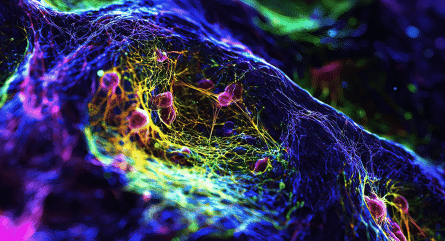It revolutionized biology research, but CRISPR-Cas9 genome editing has not changed the delivery of clinical care. There are many unanswered questions about the safety, accuracy, and ethics of genome editing in humans. But, by the end of 2021, we may get the first glimpse of data from a clinical trial of an in vivo CRISPR-Cas9 treatment for an inherited form of blindness that strikes in infancy.
Before their first birthday, children with Leber congenital amaurosis 10 (LCA10) start to exhibit signs of vision loss. They may grab at a toy and miss it, or not see a bottle being offered to them, especially in low light. Severe light sensitivity can make it hard for these children to go outside from inside or even adapt to the flick of a light switch. As the disease takes hold, parents may notice involuntary eye movements (nystagmus), head bobbing, or habitual pressing on the eyes with fingers or fists.
It would be a remarkable advancement—using CRISPR-Cas9 genome editing to restore vision to people who are blind. It is the kind of advancement that drives researchers to spend long days, late nights, and many weekends in the lab.
CRISPR-Cas9 trial to treat blindness
 In the first use of in vivo CRISPR-Cas9 genome editing, clinicians at Oregon Health & Science University (OHSU) used the treatment AGN-151587 (EDIT-101) for LCA10 as part of the BRILLIANCE trial in 2020.
In the first use of in vivo CRISPR-Cas9 genome editing, clinicians at Oregon Health & Science University (OHSU) used the treatment AGN-151587 (EDIT-101) for LCA10 as part of the BRILLIANCE trial in 2020.
“The first patient dosed in the BRILLIANCE clinical trial marks a significant milestone toward delivering on the promise and potential of CRISPR medicines to durably treat devastating diseases such as LCA10,” said Cynthia Collins, president and CEO of Editas Medicine, a biotech company working with Allergan to develop AGN-151587, in a press release.
Eighteen patients will be treated as part of the BRILLIANCE trial, beginning with adults and advancing into children over the age of three.
Genomic mutations in LCA10
Up to 17 different genes are associated with LCA10, but most cases are caused by GUCY2D, CEP290, and RPE65. AGN-151587 treats the CEP290 mutation.
“The most common mutation in the CEP290 gene that is associated with severe early-onset vision loss is an intronic mutation that results in the inclusion of a cryptic exon, an abnormal exon in the gene, so the gene doesn’t function,” said Eric A. Pierce, MD, PhD, principal investigator of the BRILLIANCE trial at Massachusetts Eye and Ear, where he is director of the Inherited Retinal Disorders Service, in a JAMA interview.
AGN-151587 is a sub-retinal injection. Narrow instruments are placed inside the eye to remove the vitreous gel and inject a small amount of the drug.
“At its core, it is a combination of a Cas9 enzyme, which is really good at cutting DNA, and a guide RNA, which directs the Cas9 enzyme to a specific location in the genome,” said Dr. Pierce.
Why CRISPR-Cas9 was used first in the eye
The eye is well suited for the first in vivo use of CRISPR-Cas9 genome editing. Eyes are small, easily accessed for minimally invasive treatment, and convenient to monitor for treatment response. Plus, you can treat one at a time, using the other eye for contralateral control. Adverse effects, such as a tumor would also be easy to detect and ablate. CRISPR-Cas9 in LCA10 also makes sense because it is caused by a single gene mutation.
“If the mutation is removed, that could restore gene function and hopefully restore vision,” said Dr. Pierce.
Gene therapy transforming treatment for retinal diseases
As transformative as this application of CRISPR-Cas9 genome editing is to restore vision loss, it is only one of the emerging approaches in ocular genomic medicine.
In 2017, the US FDA approved an adeno-associated virus (AAV) vector-based gene therapy called LUXTURNA™ (Spark Therapeutics, Inc) to treat LCA caused by a RPE65 mutation by delivering a normal copy of the gene directly to the retinal cells. Additional AAVs are under investigation to treat other genes, including: CHM, CNGA3, CNGB3, PDE68, RLBP1, RPGR, RS1, Dr. Pierce noted in a recent research seminar.
Enrollment recently closed for the phase 2/3 Illuminate clinical trial of Sepofarsen, an antisense therapy to correct the CEP290 mutation in LCA10. Antisense oligonucleotide therapies are also in development to correct inherited splicing defects in the RHO and USH2A8 genes, which cause retinal disorders. After lecturing on new gene-based therapies to seminar attendees, Dr. Pierce explained how the advancements were changing the conversation with patients. “Even if it takes several years to understand the causes of disease and eventually get a genetic therapy developed, we’re talking with patients about that opportunity,” he said. “And just a little bit of cautious optimism, that little bit of hope, really changes my clinical practice.”
Disclaimer: This article is for informational purposes only. IDT's products are generally offered for research use only and are not intended for use in clinical applications. This article is not intended to promote the use of any IDT products outside of use in research, unless otherwise agreed upon in writing.
References



























